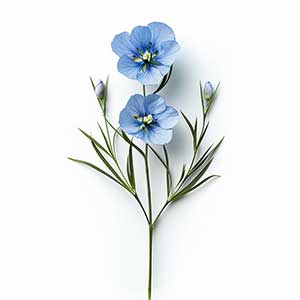'Flax, scientifically known as Linum usitatissimum, is primarily known for its seeds and fiber, but the flower itself holds a unique place in cultural and aromatic contexts. Historically, flax has been cultivated since ancient times, with evidence of its use dating back to ancient Egypt, where flax fibers were used to make linen for clothing and other purposes. The flowers, though less prominently noted in historical texts than the fibers, have been appreciated for their delicate beauty and subtle fragrance. Flax flowers emit a subtle, sweet, and slightly herbal aroma, which makes them a unique addition to fragrance compositions. In perfumery, flax flower notes are used to introduce a clean, crisp, and somewhat airy quality to scents. This note can be thought of as adding a touch of serene, natural elegance, evoking images of linen blowing gently in a spring breeze—a symbol of purity and freshness. The essential oils from flax flowers are not commonly extracted for commercial use due to the delicate nature of the flowers and the predominance of the plant\'s use for seeds and fibers. However, synthetic representations or accords inspired by flax flowers are utilized to mimic their light, fresh, and clean scent in perfumes. These accords are often used in fragrances that aim to convey a sense of calm, freshness, and natural simplicity.
Conceptually, flax flower in a fragrance evokes feelings of cleanliness, comfort, and understated elegance. It is often used in scents that aim to be unobtrusive yet memorable, suitable for 'close to the skin' perfumes and day wear fragrances that emphasize an intimate experience.
Natural or Synthetic?
Natural extraction of Flax Flower is not commercially viable due to the delicate nature of the flowers and greater value of seeds and fibers, leading to the use of synthetic versions to replicate its scent.
Fragrance Families Flax Flower Most Commonly Found In
Show fragrances that contain Flax Flower as a note



